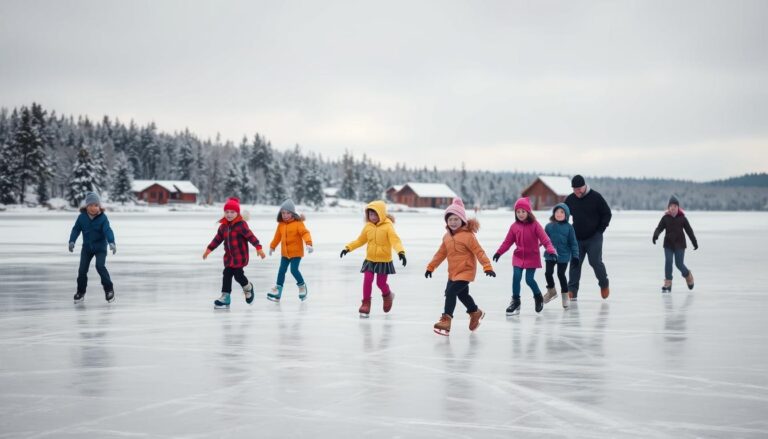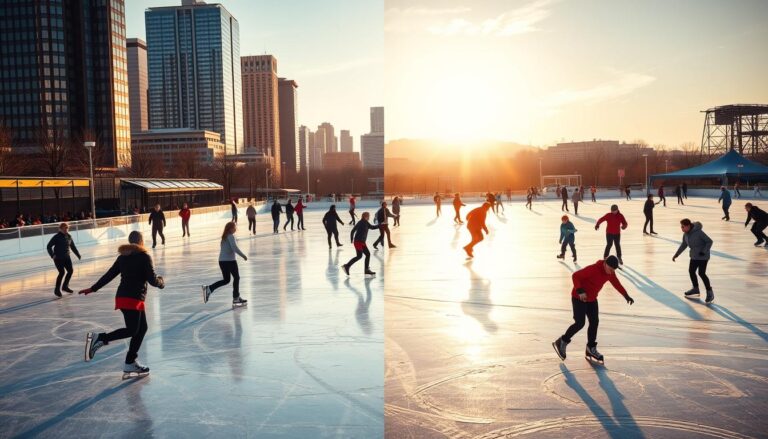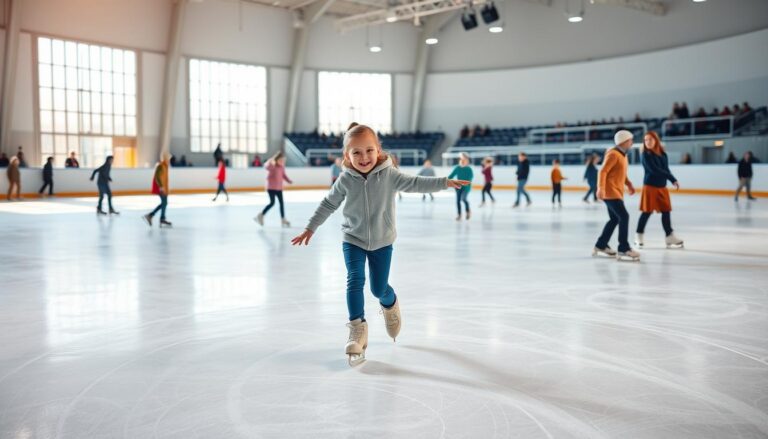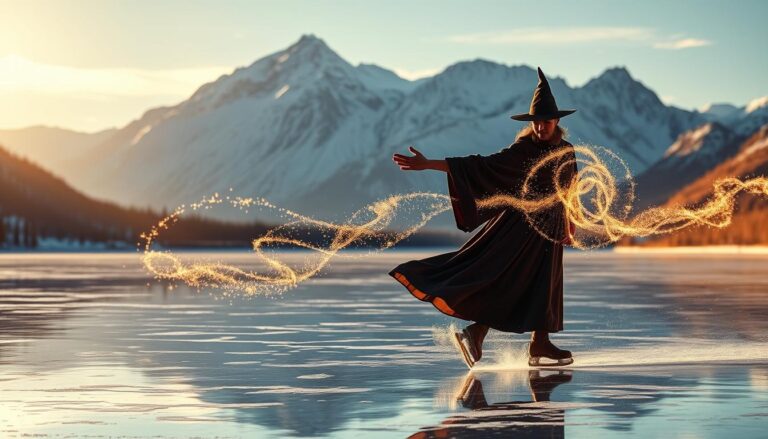Ice Skating: Is It Considered a Sport?
Imagine yourself moving smoothly on a clear ice rink. Your blades make precise paths as the cool air hits your face. Does ice skating really need true athletic skill? The answer might surprise you.
Ice skating is more than just fun. It’s a complex sport that tests physical strength, technical skills, and artistic flair. Skaters spend years perfecting their moves, needing great coordination, balance, and muscle control.
At the Winter Olympics, ice skating’s tough demands are clear. Skaters work hard to build strength, flexibility, and power. Their training is as tough as any elite athlete’s.
Figure skating and speed skating show ice skating’s true sport status. Each type requires precision, endurance, and lots of practice. It’s not just a casual activity anymore.
Olympic recognition proves ice skating’s athletic value. Judges look at technical skill, artistic flair, and athletic performance. These criteria highlight ice skating’s complex and demanding nature.
Ice skating, whether for fun or competition, is a tough activity. It turns simple movements into amazing displays of human ability. Skaters challenge themselves, defy gravity, and show incredible athletic talent with every show.
Understanding the Athletic Nature of Ice Skating
Ice skating is more than just a fun activity. It’s a tough sport that needs amazing physical skills. Skaters turn the ice into a place where strength, precision, and art come together.
Ice skating is very demanding. Skaters get special physical abilities that make them stand out. They train in many ways to get better at ice skating.
Physical Demands and Athletic Requirements
Skaters need to have certain physical traits:
- Core strength for balance and stability
- Lower body power for explosive jumps
- Cardiovascular endurance
- Flexibility for complex movements
- Muscular coordination
Core Components of Athletic Performance
Ice skating is not just about moving. Athletes work on key skills through hard training:
| Performance Component | Specific Skills Developed |
|---|---|
| Balance | Precision edge control, weight distribution |
| Power | Jump height, rotational speed |
| Endurance | Extended routine performance |
Competitive Elements in Ice Skating
Competitive ice skating is a mix of skill and art. Skaters use ice skating techniques with precision and keep their art alive. Each show is a mix of skill and creativity.
Skaters burn about 400-450 calories per hour. This shows how intense ice skating is. Their training is as tough as Olympic athletes, proving ice skating’s true athletic side.
The Evolution of Ice Skating as a Competitive Discipline
Ice skating competitions have changed a lot over time. They began as a way to get around in winter in the Netherlands. Now, they are a sport loved by millions around the world.
The history of competitive ice skating began in the 13th century. Dutch merchants used skates to travel on frozen canals. They started something big, which would become the ice skating competitions we know today.
- 1400s: First recorded skating competitions in Scotland
- 1850s: Organized skating clubs emerge in Europe
- 1896: First World Figure Skating Championships
- 1908: First Olympic ice skating event
Technology has been key in making ice skating competitions better. New blade designs, special skating surfaces, and better training have changed the sport. It’s now a complex athletic performance.
| Era | Key Development | Impact on Ice Skating Competitions |
|---|---|---|
| 19th Century | Steel Blade Invention | Enhanced Speed and Precision |
| Early 20th Century | Standardized Rink Sizes | Consistent Competition Environments |
| Mid-20th Century | Professional Judging Systems | Objective Performance Evaluation |
Today, ice skating competitions are a mix of sports and art. Skaters do incredibly complex routines. They need great physical skill, technical precision, and creativity.
Is Ice Skating a Sport? Breaking Down the Definition
Ice skating is more than just a fun activity. It’s a real sport that requires skill and hard work. It’s not just about moving smoothly on the ice. It also needs physical strength, mental focus, and technical skill.
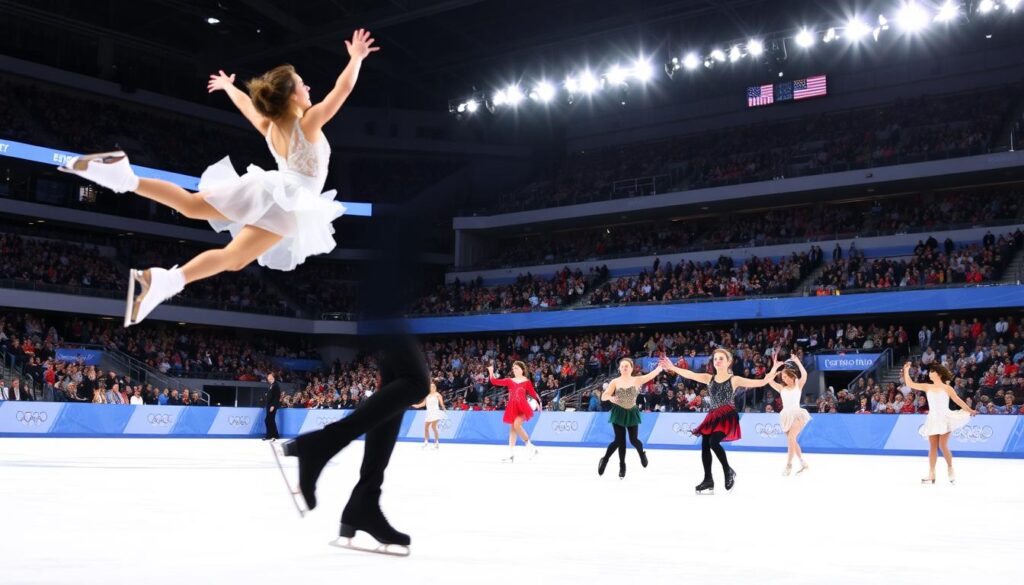
To understand if ice skating is a sport, we need to look at its key features. It has all the qualities of a sport, like intense training and strict rules.
Olympic Recognition and Status
The International Olympic Committee’s approval proves ice skating’s status as a sport. Olympic competitions highlight athletes’:
- Extreme physical endurance
- Technical mastery
- Years of dedicated training
- Complex performance skills
Competitive Framework and Structure
Ice skating has clear rules for competitions. Athletes compete in different areas, each with its own rules and judges’ criteria. The sport includes:
- Singles skating
- Pair skating
- Ice dancing
- Synchronized skating
Scoring Systems and Judging Criteria
Ice skating uses detailed scoring to judge both skill and artistry. Judges look at many factors to fairly evaluate each performance.
The technical score checks things like jumps and footwork. The component score looks at the artistic side, like skating ability and music interpretation.
Different Types of Ice Skating Disciplines
Ice skating is a world full of different disciplines. Each one challenges athletes in its own way. From the grace of figure skating to the speed of racing, each discipline requires special skills.
The main ice skating disciplines are very diverse. They differ in technique, performance, and what they focus on:
- Figure Skating: An artistic sport that combines athletic jumps, spins, and choreographed moves.
- Speed Skating: A competition that focuses on speed, with races and time trials.
- Ice Dancing: A partnered sport that emphasizes rhythm, interpretation, and artistic expression.
- Synchronized Skating: A team sport that requires precise group formations.
Each discipline in ice skating has its own challenges. They all need special training.
| Discipline | Key Characteristics | Primary Skills Required |
|---|---|---|
| Figure Skating | Artistic performance with technical elements | Jumping, spinning, choreography |
| Speed Skating | Racing on oval tracks | Endurance, acceleration, technique |
| Ice Dancing | Partnered rhythmic performance | Synchronization, musicality, artistry |
| Synchronized Skating | Team precision skating | Coordination, uniformity, timing |
Whether you love the elegance of figure skating or the power of speed skating, each discipline is a unique way for athletes to show their skills on ice.
Essential Ice Skating Techniques and Skills
Ice skating techniques are key for any skater, from beginners to pros. They need dedication, practice, and to know how their body works on ice. Knowing the basic movements is vital for success.
Building strong ice skating skills takes time and effort. It’s about combining physical strength, balance, and creativity.
Basic Skating Movements
Every skater starts with basic movements. These are the foundation for more advanced skills. The main techniques include:
- Forward skating with proper weight distribution
- Backward skating techniques
- Stopping methods (snowplow and hockey stop)
- Gliding on both single and multiple edges
Advanced Technical Elements
As skaters get better, they learn more complex techniques. These need precision and athleticism:
- Crossovers in both forward and backward directions
- Intricate footwork sequences
- Jumps with multiple rotations
- Advanced spinning techniques
| Skill Level | Key Techniques | Difficulty Rating |
|---|---|---|
| Beginner | Basic gliding, stopping | Low |
| Intermediate | Crossovers, simple jumps | Medium |
| Advanced | Complex spins, multi-rotation jumps | High |
Artistic Components
Ice skating techniques also involve art. Skaters need to mix technical skill with graceful movement. This creates a performance that wows the crowd.
The best skaters know that ice skating techniques are about more than just moving. It’s about telling a story through movement, rhythm, and feeling.
Professional Ice Skating Competitions and Events
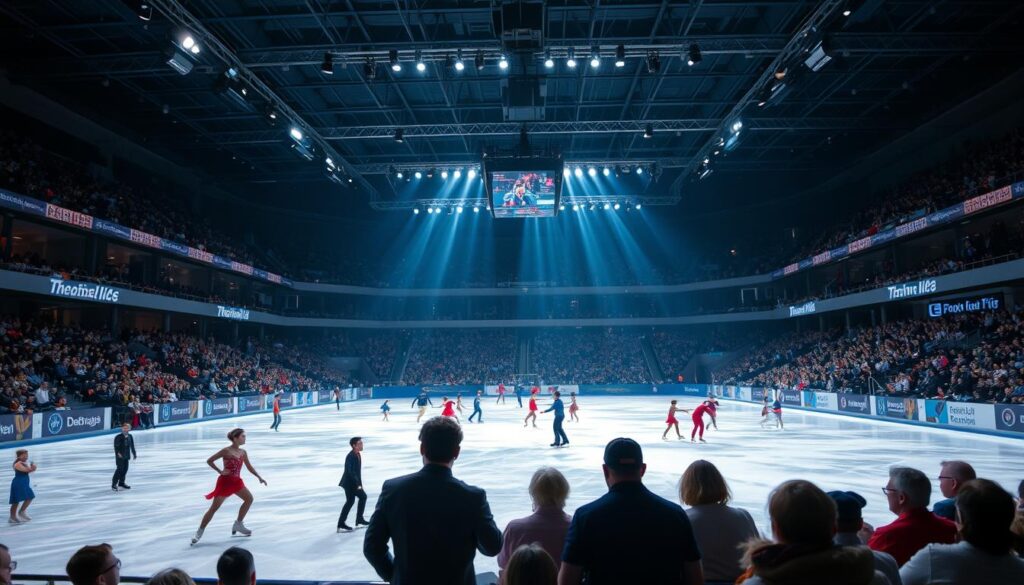
The world of ice skating competitions is a peak of athletic skill and artistic flair. It showcases athletes who blend strength with elegance on ice.
Competitive ice skating offers many exciting chances for skaters to show their talents:
- Grand Prix Series
- World Championships
- National Championships
- International Skating Union (ISU) Events
Ice skating competitions have different levels and areas. Skaters must pass tough tests to join the best events.
| Competition Type | Qualification Criteria | Prize Range |
|---|---|---|
| Grand Prix Final | Top 6 skaters from series events | $25,000 – $75,000 |
| World Championships | National team qualifications | $50,000 – $100,000 |
| National Championships | Top regional performers | $10,000 – $25,000 |
Top skaters train for years to master their routines. Technical skills, artistic interpretation, and physical endurance are key for judges.
The money side of ice skating shows big wins for top athletes. Skaters earn from prizes, sponsorships, and shows.
Training Requirements for Competitive Ice Skaters
Competitive ice skating needs a lot of hard work and special training. Skaters spend years getting better through tough physical and mental training.
Physical Conditioning Programs
Ice skating training focuses on getting physically fit. Skaters work on different areas:
- Strength training for muscle power
- Flexibility exercises to enhance range of motion
- Cardiovascular conditioning for endurance
- Balance and core stability workouts
Mental Preparation Strategies
Top athletes know that mental toughness is key. They use special techniques to stay strong:
- Visualization techniques
- Performance anxiety management
- Concentration and focus drills
- Goal-setting workshops
Practice Schedules and Routines
Professional skaters have to be very disciplined. They usually practice 4-6 hours a day.
They mix on-ice training with off-ice conditioning. They plan their training carefully. This helps them improve and avoid getting too tired.
Ice Skating Equipment and Gear Essentials
Choosing the right ice skating equipment is key to a great skating experience. It doesn’t matter if you’re new or experienced. Knowing the essential gear is vital for both performance and safety.
The base of any skating setup is the skates. Different types are needed for different skating styles:
- Figure Skating Skates: Have special toe picks for jumps and spins
- Speed Skating Skates: Low-cut boots for speed and ease of movement
- Hockey Skates: Strong boots with curved blades for quick turns
When picking skates, consider a few important things:
| Factor | Importance | Recommendation |
|---|---|---|
| Fit | Critical | Snug but not tight, with minimal heel movement |
| Blade Quality | High | Stainless steel, proper alignment |
| Ankle Support | Essential | Firm yet flexible construction |
More than just skates, other gear is needed for comfort and safety:
- Blade Guards: Protect blades when walking off the ice
- Soakers: Keep blades dry and prevent rusting
- Padded Clothing: Reduces impact during falls
- Gloves: Provide warmth and grip
Pro skaters choose top-notch gear for better performance and safety. Newbies should look for comfortable, well-fitting gear that lets them move freely.
The Role of Coaches and Training Programs

Every top ice skater has a dedicated coach. This coach turns raw talent into winning performances. Ice skating training programs are key to making elite athletes. They mix technical skills, artistic flair, and mental toughness.
Professional coaches are vital in guiding skaters. They use complex training methods that do more than teach basic skills. They create plans that fit each skater’s strengths and needs.
Coaching Certification Requirements
To become an ice skating coach, one must prepare a lot and get certified. The main steps are:
- Passing advanced skating tests
- Getting certified by the U.S. Figure Skating Association
- Clearing background checks
- Keeping up with ongoing training
Training Methodology Insights
Good ice skating training programs use different ways to grow:
- Physical workouts and strength training
- Improving technical skills
- Learning mental preparation
- Enhancing artistic performance
Coaches know each athlete needs a special plan to reach their best in ice skating.
Health Benefits and Physical Advantages of Ice Skating
Ice skating is more than just fun. It’s a full-body workout that changes your health in amazing ways. It boosts both your physical and mental well-being.
Ice skating combines cardio and muscle building. You can burn 300-600 calories per hour, depending on how hard you skate. It’s a great alternative to the gym.
- Improves overall body balance and coordination
- Strengthens core muscle groups
- Enhances cardiovascular endurance
- Develops lower body strength
Gliding on ice is low-impact, which is good for your joints. Skaters build strong leg muscles and improve core stability with practice.
| Muscle Group | Engagement Level | Benefit |
|---|---|---|
| Quadriceps | High | Improved leg strength |
| Core Muscles | Moderate to High | Enhanced stability |
| Calves | High | Better balance |
Ice skating also helps your mental health. It lowers stress, boosts mood, and sharpens focus. Skaters often feel more confident and relaxed.
Ice skating is great for everyone, whether you’re new or experienced. It’s a fun way to get fit and feel better.
Famous Ice Skaters Who Shaped the Sport
The world of ice skating has been changed by amazing athletes. They pushed limits and caught the world’s attention. These famous ice skaters didn’t just compete; they changed the sport with their incredible skills and heartfelt performances.
Some legendary ice skaters have made a lasting impact on competitive skating. Their stories are more than just athletic wins. They show dedication, innovation, and artistic flair.
Olympic Champions and Their Impact
- Peggy Fleming changed American figure skating in the 1960s
- Dorothy Hamill introduced a new spinning technique with her signature move
- Scott Hamilton made men’s figure skating exciting with his dynamic shows
- Michelle Kwan became a global icon with her elegant style
Revolutionary Performers in History
These famous ice skaters didn’t just compete; they changed what’s possible on the ice. They brought new techniques and artistic views to the sport.
- Sonja Henie added glamour and performance art to skating
- Dick Button was the first to do a double axel in competition
- Yuzuru Hanyu raised the bar for artistic expression in men’s figure skating
- Midori Ito was the first woman to land a triple axel in competition
Their legacy keeps inspiring new skaters. It shows that true athleticism is a mix of technical skill and passionate storytelling.
Rules and Regulations in Competitive Ice Skating
Competitive ice skating has strict rules to ensure fairness and show off athletes’ skills. These rules cover all aspects of skating, from technical moves to artistic flair.
To understand these rules, we need to look at several important areas. Skaters must follow detailed guidelines that judge their technical skills and artistic expression.
- Program Length: Typically 4-5 minutes for senior-level competitions
- Costume Restrictions: Must be elegant and athletic
- Technical Element Requirements: Specific jumps, spins, and step sequences
The scoring system in ice skating is complex. It breaks down performance into two main parts:
| Scoring Category | Maximum Points | Evaluation Criteria |
|---|---|---|
| Technical Score | 50 Points | Difficulty of elements, execution precision |
| Artistic Impression | 50 Points | Choreography, musical interpretation, skating skills |
Each ice skating discipline has its own rules. Figure skating emphasizes artistic performance, while speed skating focuses on speed and technique.
Skaters must show incredible skill while following these rules. Judges look at every detail, from footwork to aerial moves. This ensures a full evaluation of their performance.
The Difference Between Figure Skating and Recreational Ice Skating
Ice skating has two main types: figure skating and recreational ice skating. They cater to different skill levels and interests. Figure skating and recreational ice skating are not the same, even though they both involve gliding on ice.
Knowing the differences between figure skating and recreational ice skating helps you choose your ice skating path.
Technical Requirements: Precision and Skill
Figure skating requires a high level of technical skill. It’s different from recreational ice skating. Skaters spend years learning complex moves:
- Intricate jump sequences
- Precise spins and rotations
- Choreographed footwork patterns
- Advanced edge control
Performance Aspects: Artistry versus Enjoyment
Figure skating is more about performance than recreational ice skating. It’s like a dance on ice. Recreational skating is about having fun and moving on the ice.
| Aspect | Figure Skating | Recreational Ice Skating |
|---|---|---|
| Skill Level | Professional/Competitive | Casual/Beginner |
| Training Focus | Technical Mastery | Basic Movement |
| Performance Style | Choreographed Routine | Informal Skating |
| Equipment | Specialized Figure Skates | Standard Rental Skates |
Whether you love the art of figure skating or enjoy the casual fun of recreational ice skating, both are great ways to enjoy ice skating.
Ice Skating’s Impact on Youth Athletics
Ice skating is great for young athletes, changing how we see physical education and personal growth. It gives kids a chance to learn important skills that go beyond the ice.
Young ice skating programs help kids develop amazing athletic skills. The benefits include:
- Enhanced balance and coordination
- Improved muscular strength
- Mental discipline and focus
- Confidence-building experiences
Many professional athletes say ice skating helped start their careers. NHL players, for example, say figure skating helped them control their edges and move better.
Competitive ice skating programs teach kids valuable life skills. They learn:
- Goal-setting strategies
- Time management
- Emotional resilience
- Team collaboration
Studies show kids who skate do better in body awareness and spatial intelligence. Ice skating pushes kids physically and mentally, getting them ready for sports later on.
Parents looking for a sport that helps kids grow in all areas will find ice skating excellent.
Career Opportunities in Professional Ice Skating

Professional ice skating offers a wide range of career paths for those who love the sport. You might dream of competing in big ice skating events or working behind the scenes. There are many exciting ways to make a career in ice skating.
Competitive ice skating competitions open up different career paths for talented skaters. Skaters can choose from several career options:
- Professional Competitive Skater
- Ice Show Performer
- Skating Coach
- Choreographer
- Technical Specialist
- Competition Judge
Each career path needs special skills and hard work. Professional competitive skaters aim for top spots in national and international competitions. They work on perfecting their skills and artistry. They can make good money from prizes, sponsorships, and contracts.
There are also other careers in ice skating:
- Coaching: Teaching new skaters at all levels
- Choreography: Creating skating routines
- Sports Management: Running ice skating events
- Sports Psychology: Helping athletes mentally prepare
Jobs in professional ice skating require ongoing learning, staying in shape, and a deep love for the sport. Getting certified, taking extra training, and networking can help you move into a career in ice skating.
Conclusion
Ice skating is more than just a fun activity. It requires incredible physical strength, technical skill, and artistic flair. Athletes in this field face tough training that tests their bodies and minds. This shows that ice skating is truly a sport that needs hard work and talent.
Ice skating is a complex sport that combines heart health, muscle control, and creativity. Skaters spend years perfecting their moves, turning simple steps into stunning shows of human ability. They need strength like gymnasts, flexibility like dancers, and mental toughness of top athletes.
Every time someone glides on ice, it’s a story of hard work. Both young and experienced skaters know that success comes from dedication. Whether you’re into competitive figure skating or just enjoy skating for fun, you find a powerful way to express yourself physically and artistically.
We encourage you to try ice skating yourself. You might start with basic moves or watch pro skaters. Remember, every great skater began with curiosity, passion, and a desire to push their limits. What skating adventure will you start today?

